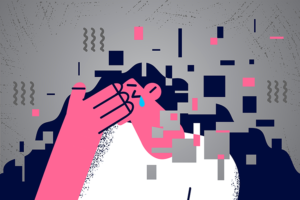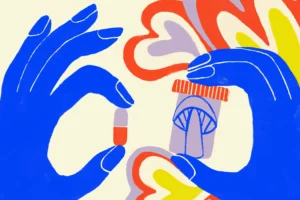By NAMI Staff
In a segment of his show “Real Time with Bill Maher,” famed comedian, television host and political commentator Bill Maher joked that then-president Donald Trump received his news from “a passing mental patient.” The implication was, given Maher’s criticisms of Trump’s competence, that such patients lack any awareness of their surroundings or the intelligence to determine fact from fiction. Of course, Maher’s joke got the laughs he was looking for. But the fact that a public figure can entertain an audience by resorting to negative stereotypes of people with mental illness is proof that stigma is alive and well in society — and it does not need to lurk in the shadows.
Popular comedy sets, TV shows and social media discourse alike are rife with jokes about “looney bins,” “straitjackets” and “crazy people” hearing voices. Moreover, these harmful depictions often go unchallenged, allowing stigma to proliferate.
Understanding The Roots Of Stigma
It seems that this pervasive stigma lies in the time-worn misconception that mental health conditions are a personal and moral failing — rather than illnesses requiring treatment, much like any other health issue. As a result, far too many people see those with mental health conditions as “damaged” people who are responsible for their own afflictions and simply unable to make better choices.
This misguided judgment, in turn, leads to the isolation and marginalization of people with mental illness. Some internalize this stigma, and their shame prevents them from seeking help. Others may seek help but feel obligated to hide their experience for fear of social and professional repercussions. Both of these outcomes are unacceptable and perpetuate a cycle of judgment, shame and pain.
Unfortunately, a secondary perpetrator of stigmatization can be the medical profession itself. For far too long, practitioners have approached physical health and mental health separately. Physical health, it seems, is treated as “real medicine,” while mental health is regarded as a separate, and often lesser, discipline. This separation also impacts the language we use. When someone receives inpatient treatment for a physical illness, we simply say that someone was “hospitalized.” When referring to inpatient treatment for mental health conditions, we often use much more offensive language about the nature of treatment, such as “went to the madhouse.”
Combatting Stigma With Facts And Demanding Better Representations
To begin changing the cultural taboo, we need to talk more about the reality of mental health. Understanding the basic science is a good place to start: The brain is an organ, and, like other organs, illness surfaces when it malfunctions. Disruptions in mood, appetite and sleep, for example, are indicators of a chemical imbalance in the brain. A more accurate representation of mental illness (in media and elsewhere) would understand that mental health is health — and it has physical origins. Deepening this understanding will allow us to move away from the misconception that mental health conditions are a choice.
Of course, perfectly representing mental illness — in media and beyond — is challenging. Living with mental illness, much like having a physical ailment, does not translate to one universal experience; accordingly, there is no singular, accurate characterization of a person with a mental illness. However, we must demand a variety of representations rather than settle for the tired, harmful tropes of a “mental patient” with a loose grasp on reality.
In actuality, mental illness can affect anyone, anywhere and at any time. It doesn’t matter what a person’s moral fortitude or station in life is. Additionally, mental illness will present differently in different people. It can look like a person detached from reality. It can also look like creative genius (Virginia Woolfe, Pyotr Ilyich Tchaikovsky and Walt Whitman, to name a few).
It is time to extinguish the embers of mental health stigma. This process cannot happen overnight, as negative conceptions are deeply woven into our socialization. Stigmatizing language goes unchallenged, promoting a silent acceptance of the status quo. As a result, harmful language and careless jokes litter our social media feeds and flood our screens. But these jokes hurt real people and ignore their humanity. Mental illness has many faces, and it could be your sibling, parent, friend or partner — and their worth must not be measured by what diagnosis they have, but who they are.
This piece was written by an anonymous contributor with the help of NAMI Staff.
Source: https://nami.org/Blogs/NAMI-Blog/April-2022/Mental-Illness-Is-Not-a-Joke-Fighting-Stigma-in-Pop-Culture




